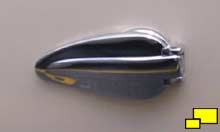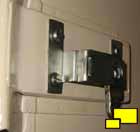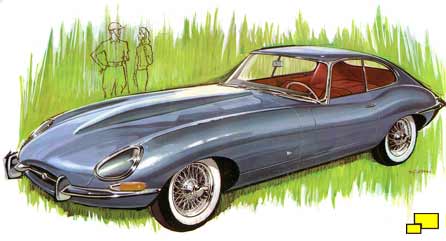
|
|
|
|
Jaguar E-Type Timeline, Part I
|
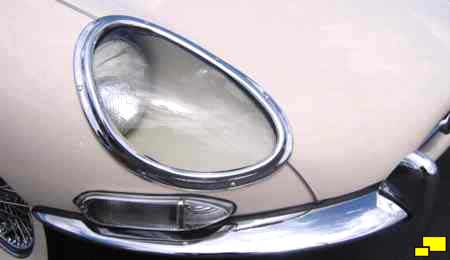
|
|
|
|
The Series I E-Type was introduced at the Geneva Auto Show on March 15, 1961. The coupe was the first to be shown; a short time later two roadsters and two coupes were on display at the New York Auto Show. The price was $5,595 (£1,830) for the roadster and £1,954 for the coupe, a bargain by any measure. Engine displacement was 3.8 liters. The only transmission offered was a racing Moss four speed manual, with a non-synchromesh first gear. The earliest cars featured louvres welded into the bonnet; soon after they were incorporated into the hood. 2,013 E-Types were sold; 1,625 roadsters and 388 coupes.
|
|
Spotting Early E-Types
|
|
|
|
Above left: An exterior handle was used to release the bonnet on very early cars. Access was covered by spring loaded teardrop shaped escutcheons. Right: Interior view of the latch mechanism. Later cars used a release system accessible from inside the car.
Early E-Types are often labeled "flat floor" in reference to the lack of a dropped floor area which offered more foot room in subsequent cars.
Below: Very Early E-Types featured "welded louvres". Later the bonnet manufacturer, Abbey Panels, developed a tool which enabled them to press the louvres into the bonnet itself.
|
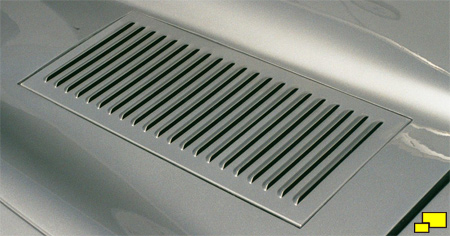
|
|
|
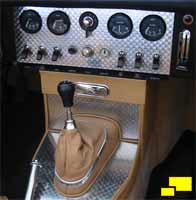
|
Interior on 3.8 liter E-Type. Left: The factory brochure referred to the surface material as "matt grained finished to eleminate reflections". Right: 3.8 liter seat, which according to the sales literature, was "upholstered in finest quality Vaumol leather over Dunlopillo foam rubber cushions". They were not adjustable and by some accounts, not comfortable either. Photo shows a '64 interior with armrest and upholstered console.
|
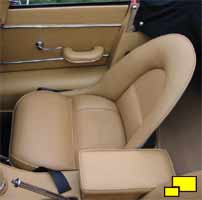
|
|
|
|
|
|
|
|
|
The end of the "flat floor" E-type came during the 1962 model year when heel wells were fitted. This resulted in a slight increase in interior leg and foot room. Right: A hardtop was available as an option. 6,253 E-Types were sold; 2,749 roadsters and 3,504 coupes.
|
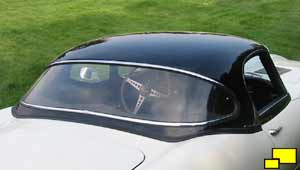
|
|
|
|
|
No major changes. 4,010 E-Types were sold; 1,931 roadsters and 2,079 coupes.
|
|
|
|
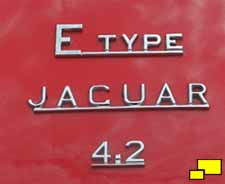
|
Left: The 1964 E-Type proudly announced its increased engine size on the boot lid. Previous years simply read "Jaguar". Right: Seats were adjustable and offered improved comfort and support albeit at the expense of an aesthetic downgrade.
|
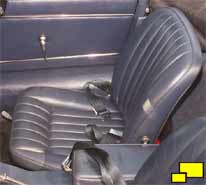
|
|
|
Engine displacement was increased from 3.8 to 4.2 liters. There is still some debate as to whether it was an improvement, as the larger engine was less rev happy. The power output was the same (265 hp), but torque increased from 260 lb-ft to 283 lb-ft. The torque improvement was welcomed by the American customers, as were improvements in the area of oil consumption. Another major change was the introduction of an all synchromesh four speed transmission with superior shifting characteristics. The electrical system was converted from a positive to a negative ground system. Aluminum interior surfaces were replaced with a black vinyl material. 874 E-Types were sold; 410 roadsters and 464 coupes.
|
|
|
|
|
|
|
The 2+2 coupe was introduced. It was clearly aimed at the American luxury market with its increased interior accommodations. The wheelbase was increased by 9.0 inches, and two tiny seats of questionable value were added. All the length increase seemed to be in the doors, making entry and exit easier. The weight increased by 200 lbs, and performance suffered accordingly. Consistent with the new intentions, an automatic transmission (a Borg-Warner three speed) was available in the 2+2, a first for the E-type. The 2+2 coupe is easily identifiable by the chrome strip at the top of the door panel. Many feel that the car is badly proportioned, and the current market seems to agree as 2+2 coupes command the lowest prices of all the E-types. 5,262 E-Types were sold; 2,220 roadsters, 3,041 coupes and one 2+2 coupe.
|
|
|
|
|
The first year the 2+2 coupe was commonly available. The family oriented marketing of the car (as in the brochure illustration to the right) was strange and must have been disconcerting for fans of the E-type. It was referred to as a "2plus2", "XKE sedan" and "2+2 Family Coupe". The advertisements called attention to the power steering, automatic transmission and air conditioning. 6,826 E-Types were sold; 2,314 roadsters, 1,919 coupes and 2,593 2+2 coupes.
|
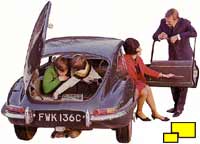
|
|
|
|
The last year closed headlight cars were available. A few of the later built cars started to incorporate the Series 1 1/2 changes. 5,032 E-Types were sold; 2,510 roadsters, 1,220 coupes and 1,302 2 + 2 coupes.
|
|
|
|
Note: Clicking on an image with this symbol ( ) will lead to a larger image. ) will lead to a larger image.
(A new window will open in your browser)
|
|
Jaguar E-Type Forum
Contact other enthusiasts with Jaguar E-Type questions, comments and advice!
Click here to visit the WebCars! Jaguar E-Type Forum.
|
|
|

Suggestions? Comments? Tell us!!!
|

|
|




